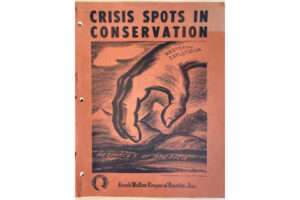 The Library has gained access to the online archive “Environmental History: Conservation and Public Policy in America, 1870-1980” thanks to the Institute for Governmental Studies Library’s contribution of nearly 2,000 items to this collection.
The Library has gained access to the online archive “Environmental History: Conservation and Public Policy in America, 1870-1980” thanks to the Institute for Governmental Studies Library’s contribution of nearly 2,000 items to this collection.
A detailed description from the vendor’s website:
Starting in the late nineteenth century, in direct response to the Industrial Revolution, forces in social and political spheres struggled to balance the good of the public and the planet against the economic exploitation of resources. Environmental History: Conservation and Public Policy in America, 1870–1980 chronicles various responses in the United States to this struggle through key primary sources from individual activists, advocacy organizations, and government agencies.
Collections Included
- Papers preserved at Yale University of George Bird Grinnell, a founding member of the Boone and Crockett Club, one of the earliest American wildlands preservation organizations; a founder of the first Audubon Society and New York Zoological Society; and editor for 35 years of the outdoorsman magazine Forest and Stream, which played a key role as an early sponsor of the national park movement and Migratory Bird Treaty Act of 1918.
- Records housed at the Denver Public Library of the American Bison Society, an organization that sought to save the American bison from extinction and succeeded as the first American wildlife reintroduction program.
- Also housed at the Denver Public Library, the papers of key women conservationists, such as Rosalie Edge and Velma “Wild Horse Annie” Johnston. Edge formed the Emergency Conservation Committee to establish Hawk Mountain Sanctuary (the first preserve for birds of prey), clashed with the Audubon Society over its policy of protecting songbirds at the expense of predatory species, and was a leading advocate for establishing the Olympic and Kings Canyon national parks. Johnston worked to end the capture and killing of wild mustang horses and free-roaming donkeys and lobbied to protect all wild equine species.
- Documents held at various institutions of the “father of forestry” Joseph Trimble Rothrock, who served as the first president and founder of the Pennsylvania Forestry Association and Pennsylvania’s first forestry commissioner. Rothrock’s work acquiring land for state parks and forests illustrates the role of key actors at state and regional levels.
- Project histories and reports of the U.S. Bureau of Reclamation from the National Archives and Records Administration, chronicling the bureau’s work on projects including Belle Fourche, South Dakota; Grand Valley, Colorado; Klamath, Oregon; Lower Yellowstone, Montana; Shoshoni, Wyoming; and more.
- Select gray literature on conservation and environmental policy from the Institute of Governmental Studies Library at the University of California at Berkeley. This vast array of documents issued by state, regional, and municipal agencies; advocacy organizations; study groups; and commissions from the 1920s into the 1970s cover wildlife management, land use and preservation, public health, air and water quality, energy development, and sanitation.